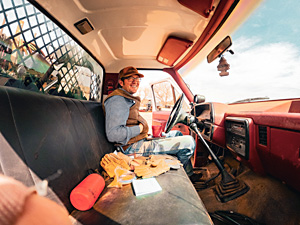For anyone focused on building or rebuilding healthy soils, it’s worth remembering that soil took eons to develop initially. Improving it doesn’t happen overnight.
That’s a lesson farmers and ranchers are learning in northern Colorado through a Citizen Science Soil Health Project funded by Western SARE. The three-year, three-county project provides free soil testing and soil-health education to producers who have signed up to participate.
The goal is to encourage practices like cover-cropping or reduced tillage that can improve soil health. But the initial benefit is providing producers a better understanding of what may and may not work in their unique environment.
Zach Thode, the manager of a cattle ranch between Fort Collins, Colorado and Laramie, Wyoming, is one of the participants.
“We are about 6,000 feet elevation and 12 miles from the Wyoming border, so a little further north than a lot of the major farming in Colorado,” he said. “We operate as a cattle ranch with the added value of some irrigated forage crops and irrigated pasture. There's reliably only about 100 to 110 days of frost-free growing, so we're a little limited in what crops we grow and we try a lot of different things to try to improve on that.”
Thode started out using organic practices to improve his soils, but the terrain had other ideas.
“There's not a lot of really flat ground and we do seem to grow more rocks than anything,” he said. “I'd been doing different levels of cover cropping and soil health projects on this ranch for nine years with some very idealistic goals and trying to do it in a very organic and passive way, but found that that was a complete struggle.”
What the soil health project showed him was that all the area growers had challenges, whether they managed their land organically or conventionally.
“That was an eye opener for me,” he said. “I was just trying to run this in a very passive, organic way and was slow to recognize that maybe adding some fertilizer and maybe a bit of herbicide, small amounts at the right times, might speed up the process. So I switched gears and started being a little bit more focused about how I was planting cover crops and how I was managing them and how I’m managing my other forage crops. We've realized fertilizers really, really helped some of these cover crops grow fast putting much more organic matter into the ground and much more forage biomass so that we can graze, cut and harvest it or put it back into the ground.”
Thode plants winter hardy cover in the fall after a row crop, or interseeded into a row crop in late summer. That mix includes turnips, radish, trit, oats for late fall or early spring grazing. If there is a potential he’ll be short of grass for his cows in early summer, he plants a spring mix of trit, oats, peas, radish and vetch that can be grazed. If it rains and there is grass for the cows he harvests that mix for dry forage, or silage and then plants another fall crop for grazing again.
Elizabeth Black conceived of the project and applied for the Western SARE grant out of an interest in soil carbon sequestration as a means of mitigating climate change. She’s hoped to enlist 30 producers in the project but ended up with 48.
“Each grower has committed to collect soil samples for testing from one site for 10 years and we run a free test on that sample every year but they can test as many other sites as they want, whenever they want, at a discounted rate,” she explained. “Then we track that data to show them how their results compare with their peers, and also how their soil test results have changed over the years.”
Western SARE funded the first three years of the planned 10-year project, and the key takeaway is that it takes time to build soil. In three years of testing at 55 sites, half improved soil organic matter levels while half didn’t, and 42 percent showed improved overall soil health scores and 58 percent had lower scores.
And while those weren’t the numbers she was hoping for, Black isn’t discouraged. When she checked in with other soil researchers in Colorado, their message was all the same: variability is the name of the game because you are measuring biology. It takes a long time to get enough data to see the trends through the noise in a system that is constantly changing.
“A lot of the soil-health success stories come from places like California and Pennsylvania where results just don't apply that well here,” she said. “My philosophy is that the 48 growers in our project are going to be able to figure out what works here and then share that information – what’s worked for them and what hasn't worked in the difficult environmental conditions we have here.”
And Black encourages that sharing
“When I go out and take soil samples, I talk with the growers and one mentioned he had a hard time with cover crops and I said, ‘You really should talk to Zach because he knows about that stuff.’” Black said. “So that's what I see as my job, trying to find out what different people are really good at and then connecting them with each other so that they talk to each other.”
That won’t happen overnight either, and COVID limited the opportunities for gathering growers together in planned workshops in 2020 and 2021. But Black believes those are just temporary setbacks because building connections and trust is a lot like building soil.
It takes time.
View Related SARE Grant:
- The Citizen Science Soil Health Project (fw19-341)
